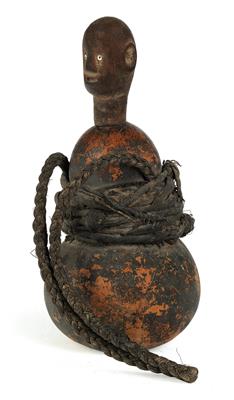Nyamwezi or Pare, Tanzania: a so-called ‘medicine calabash’ with a head as the stopper.
Nyamwezi or Pare, Tanzania: a so-called ‘medicine calabash’ with a head as the stopper.

Most tribes in Tanzania use small calabash squashes, such as this one, with anthropomorphic carved stoppers to store medicine, ‘magical substances’, ‘sacred’ oils or colour pigments. These objects are collectively known as ‘medicine calabashes’. Their precise origin can only be ascertained from the style of the figurine stopper, which is always carved from wood, or their head-shaped top.
The style of the head of the present medicine calabash implies that the object originates from the Nyamwezi or the Pare, or possibly from the Sukuma or the Zigua. It is a long oval shape inset with two white glass beads for eyes, a wide nose and an open mouth, along with large, round, recessed ears. The round stopper attached to the head in a single piece is long, reaching to the base of the calabash.
A charming, small, wholly original piece wrapped in black fabric and with a black carrying strap made of braided plant fibres. No damage and a good, old usage patina.
Height: 20.3 cm. First half of the 20th century. (ME)
Provenance: Austrian collection.
Lit.: ‘Tansania. Glaube, Kult und Geisterwelt’ by Ralf Schulte-Bahrenberg, chapter ‘Kalebassen’: ill. 7, 8, 9, 13.
Expert: Prof. Erwin Melchardt
 Prof. Erwin Melchardt
Prof. Erwin Melchardt
+43-1-515 60-465
erwin.melchardt@dorotheum.at
06.04.2017 - 15:00
- Vyvolávací cena:
-
EUR 260,-
Nyamwezi or Pare, Tanzania: a so-called ‘medicine calabash’ with a head as the stopper.
Most tribes in Tanzania use small calabash squashes, such as this one, with anthropomorphic carved stoppers to store medicine, ‘magical substances’, ‘sacred’ oils or colour pigments. These objects are collectively known as ‘medicine calabashes’. Their precise origin can only be ascertained from the style of the figurine stopper, which is always carved from wood, or their head-shaped top.
The style of the head of the present medicine calabash implies that the object originates from the Nyamwezi or the Pare, or possibly from the Sukuma or the Zigua. It is a long oval shape inset with two white glass beads for eyes, a wide nose and an open mouth, along with large, round, recessed ears. The round stopper attached to the head in a single piece is long, reaching to the base of the calabash.
A charming, small, wholly original piece wrapped in black fabric and with a black carrying strap made of braided plant fibres. No damage and a good, old usage patina.
Height: 20.3 cm. First half of the 20th century. (ME)
Provenance: Austrian collection.
Lit.: ‘Tansania. Glaube, Kult und Geisterwelt’ by Ralf Schulte-Bahrenberg, chapter ‘Kalebassen’: ill. 7, 8, 9, 13.
Expert: Prof. Erwin Melchardt
 Prof. Erwin Melchardt
Prof. Erwin Melchardt
+43-1-515 60-465
erwin.melchardt@dorotheum.at
|
Horká linka kupujících
Po-Pá: 10.00 - 17.00
kundendienst@dorotheum.at +43 1 515 60 200 |
| Aukce: | Mimoevropské a domorodé umění |
| Typ aukce: | Salónní aukce |
| Datum: | 06.04.2017 - 15:00 |
| Místo konání aukce: | Wien | Palais Dorotheum |
| Prohlídka: | 01.04. - 06.04.2017 |
